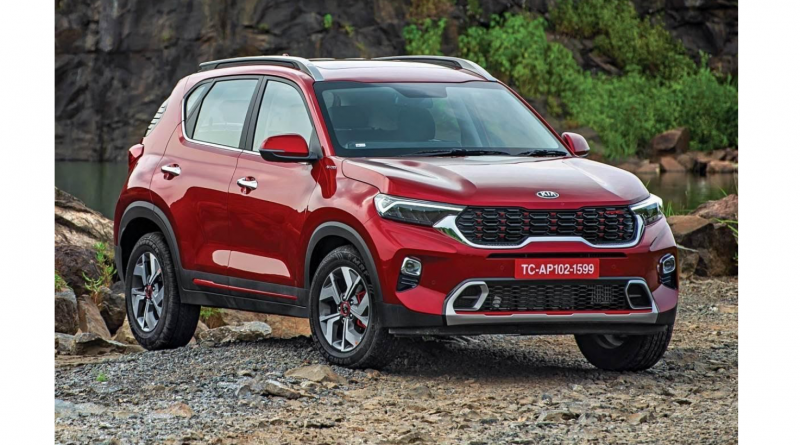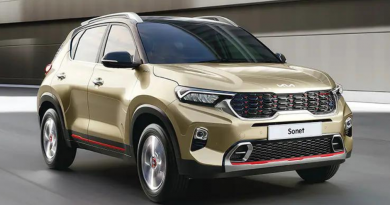Kia Sonet Features, Price, and Specification 2021
The Kia Sonet is a subcompact crossover SUV manufactured by Kia since 2020. The Sonet slots below the Seltos and is closely related to the similarly sized sibling Hyundai Venue. It is developed for the Indian market and is solely manufactured in India.
The Sonet was previewed as the Sonet Concept in February 2020. It was sold starting from 18 September 2020 in India. It is the third model from Kia in India after the Seltos and the Carnival. The variation with “5+2” seating called Sonet 7 was launched in Indonesia in April 2021.
Price & Variants:
The price of Kia Sonet starts at Rs. 6.79 Lakh and goes upto Rs. 13.35 Lakh. Kia Sonet is offered in 23 variants – the base model of Sonet is 1.2 HTE and the top variant Kia Sonet 1.5 GTX plus Diesel AT DT which comes at a price tag of Rs. 13.35 Lakh.
The sub-4m SUV is sold in six trims: HTE, HTK, HTK+, HTX, HTX+, and GTX+. 1.5 GTX plus Diesel is the top selling.
1. Body & Capacity:
The Sonet is a 5 seater SUV and has length of 3995mm, width of 1790mm and a wheelbase of 2500mm. Its Rounded corners give it a smooth frame with a satisfying look. Sonet comes with a 5-door opening and it has a great boot space of 392 L. depending on variant has a kerb weight range from 1081 kg to 1233 kg max.
In the Indian market, the Sonet occupies the sub-4-metre SUV category benefitting from the Indian tax benefits for cars shorter than 4 meters. However, the Sonet is equipped with different front and rear bumpers for export markets, increasing its length.
2. Engine:
It shares a platform with the Hyundai Venue, and though, it feels a bit different to drive, thanks to subtle changes to the tuning of the engine and suspension. There are three engines (four if you count two different power outputs for the diesel) and five gearboxes on offer; and they are offered in five combinations. An 83hp, 1.2-litre petrol mated to a 5-speed manual, a 120hp, 1.0-litre turbo petrol mated to a 7-speed DCT auto or a 6-speed iMT (clutch less manual), and a 1.5-litre diesel that puts out 100hp when coupled to a 6-speed manual.
Sonet Diesel auto:
Interestingly, the diesel is the same power-train that does duty in the Seltos, putting out an identical 115hp and 250Nm. The diesel manual gets the fixed-geometry-turbo engine.
The 115hp engine is an absolute gem, Refinement is top notch, and noise and vibrations are muted. At high revs it does get a bit gruff, but never really sounds harsh or trashy.
What’s nice is that the auto ‘box is really very well matched to the broad torque spread of the diesel power-plant, and in the Normal drive mode, it delivers a very intuitive drive experience. Sport mode, of course, does bring in a more aggressive feel, with the box holding on to the lower ratios a bit longer. But so useable and intuitive is the Normal mode that for everyday driving and even some quick dashes, it will prove to be enough for most. There’s also an Eco mode, and here too it impresses, as it turns out to be quite useable and doesn’t throttle the engine in the interest of efficiency.
The diesel auto was the quickest. In a quick test, it did the dash to 100kph in just 11.48sec compared to the petrol DCT’s 12.25sec and 13.37sec for the iMT. The diesel was also ahead in the roll-on acceleration runs.
Sonet Turbo Petrol:
The 1.0-litre turbo-petrol is shared with the Venue, Kia only offers the Sonet with the DCT and iMT. The punchy midrange and the ease with which it builds power makes it a fun drive, and while there are no paddle shifters, there is a sequential function via the gear lever, so enthusiasts can engage with the gearbox and this feisty engine. The iMT is also something we got a chance to experience and, compared to the DCT; it offers you better control over shifts.
| Fuel | Diesel | Petrol |
| Engine Displacement | 1493 cc | 998 cc, 999 cc, 1197 cc |
| Engine Type | 1.5 L CRDi VGT Diesel Engine | Smart-stream G1.2/G1.0 T-GDi |
| Max Power | 113.42 bhp@4000rpm | 81.86-118.36 bhp@6000rpm |
| Max Torque | 250 Nm@1500-2750rpm | 115-172 Nm@4200rpm |
| Transmission | 6-speed automatic | 5 & 6-speed iMT & 7-speed DCT |
3. Handling:
Ride quality on the diesel and petrol are both quite similar, the Sonet easily soaked up massive potholes with ease and the fat, 215/60 R16 tyres did a good job of smothering out our rain-ravaged roads.
In terms of handling, the diesel and petrol feel a bit different. Though both have Tilt column electric steering with Rack & Pinion type gear, the diesel has a slightly heavier steering and is a bit more nose heavy. The petrol felt nicer to steer and turned into corners with a bit more agility. Both cars feel nice and offer a great degree of confidence at high speeds, which makes them good long-distance cruisers. The steering feel on both is pretty similar – there isn’t much feedback, but on the plus side, it is light enough in the city and has enough weight at higher speeds. The light controls, decent all-round visibility, tight turning circle and compact dimensions make the Sonet very urban-friendly and easy to slot into tight parking spots.
The drive modes do alter the steering feel, though the influence is minimal and only felt in Sport mode, with the steering firming up a bit. Unique to the segment, the Sonet also
4. Brakes & Suspension:
Kia Sonet got great braking system; it has Disc brakes in front and the rear drum brakes assist the disc brakes perfectly. Like the driving modes, Kia also offers traction modes i.e. Snow, Mud and Sand.
Talking about suspension, Sonet comforts the ride with its Front McPherson Strut suspension and the Coupled Torsion Beam Axle (CTBA) on rear, both with Coil Springs.
5. Comfort:
The upright stance of the Sonet means getting in and out isn’t a task even for the elderly. Seating position is noticeably higher and this feeling is accentuated by the low window line, the large windows and the upright but slim dashboard. There’s nothing to grumble about on the ergonomics front: everything is well within reach and the thoughtfully designed stowage spaces make it easy to get used to the cabin instantly.
For instance, a small slit between the two cup holders can be used to either store your car key or have your Smartphone ‘stand’ in that space. If not, could be chose to place it on the wireless charging tray, or the shelf underneath. Door pads have room for a 1-litre bottle, and there’s a umbrella holder too. Under the front armrest, you’d find ample space for your wallet and some more knick knacks.
The driver’s seat can be adjusted for height from the HTK variant onwards, while a tilt-adjust steering is offered as standard. Despite the rather large ‘wall’ that Kia has built to merge the instrument binnacle with the infotainment console, new drivers will like the high seating position that lets you see the edge of the bonnet and the sides. This will boost confidence when driving through tricky spaces. The cabin design also connects to the exterior, with the knurled finish being mimicked on the AC vents and the fog lamp bezel being replicated in plastic for the AC louvers. Interesting triangular detailing can be seen on the speaker grilles and the door pads.
What truly stands out is the graining of the plastic used for the top half of the dash. It’s smooth to the touch and feels rich. Kia’s adding another layer of feel good by way of rich leatherette upholstery for the seats, the flat-bottom steering and the elbow rests on the door pads, Neat.
Rear seat occupants are pampered by the same smooth leatherette elbow rest pads, and a set of rear air-conditioning vents that are offered as standard. There are also twin seatback pockets. The Sonet is happy accommodating four six-footers with ease. Knee-room is just about enough.
6. Tetchy Interior:
The lengthy feature list on the Sonet will make you question if paying more for larger vehicles.
The addition of an air purifier that claims to protect against bacteria and viruses is worth appreciation. Kia says, it is made possible by using UV light and a HEPA filter. It’s also neatly integrated into the rear-AC tower, but can be controlled only through the touch-screen.
There’s an electric sunroof, climate control, cruise control, auto-dimming IRVM and a wireless charger with a thoughtful cooling function. The party piece is of course ventilated seats, nothing less than lifesavers in our sweltering conditions. And since cars are now gadgets that can be driven, the Sonet gets either an 8- or 10.25-inch touch-screen (depending on the variant you pick) — each with their own party trick. With the smaller touch-screen, you get a nifty ‘wireless projection’ feature that lets you run Android Auto and Apple CarPlay without connecting the phone via a cable.
The larger touch-screen is paired with an outstanding 7-speaker Bose sound system. The sound system on the Sonet does live up to the Bose name. With the subwoofer, this system will appeal to those who listen to a lot of EDM or hip hop — thanks to the thumping bass.
There’s another colored 4.2-inch screen inside the instrument cluster that has neat graphics for instant fuel consumption, and basic readouts for trip information. It also shows you the title of the track being played and navigation updates when you use on-board navigation. You also get to see a compass here.
To make parking easier, you get 4 front parking sensors and 2 at the rear. Feed from the camera is crisp and the guidelines turn with steering input too.
7. Exterior:
Sonet are larger than that of the Venue, while the rear is tighter. With its upright and confident face, the scaled down SUV design works well for the Sonet. In the top-spec variants, you are treated to full-LED headlamps with integrated daytime running lamps that double as turn indicators. Elements such as the wide grille with a sweet knurled chrome outline and the creases on the hood paired with the flared wheel arches give the Sonet much needed visual muscle.
You can easily tell the Sonet is 37mm taller than other SUV categories. It looks like a funky sneaker viewed from the side, especially with the roll-over hoop-like design of the C-pillar. Kia has cleverly added a gloss-black panel here to make the windscreen appear wider than it really is. This is most apparent viewed from the rear, with the connected tail lamps adding to the visual width of the Sonet. The LED treatment for the stop lamps is eye-catching, especially after sundown.
8. Safety:
Dual airbags and ABS with EBD are offered as standard across variants. The top-spec GTX+ variant additionally gets side and curtain airbags. If ISOFIX child seat mounts are a must have for you, that’s available from the HTX variant onwards. Electronic stability control, hill assist and vehicle stability management are offered as standard for the Turbo-DCT variants, and across drive-train options on the GTX+ variant. A tyre pressure monitor is bundled in for the top two variants.
The Kia Sonet is yet to be crash tested by an independent authority.
Also Read: Tata Sumo Spacio Features, Price, and Specification 2021
- Mercedes Benz E-Class | Variants and Specifications | - September 24, 2021
- Kia Sonet Features, Price, and Specification 2021 - June 6, 2021
- Tata Sumo Spacio Features, Price, and Specification 2021 - June 6, 2021




